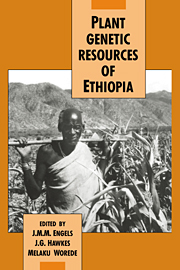Book contents
- Frontmatter
- Contents
- Contributors
- List of acronyms
- Preface
- Part I General introduction
- Part II The Ethiopian centre of diversity
- Part III Germplasm collection and conservation in Ethiopia
- Part IV Evaluation and utilization of Ethiopian genetic resources
- 18 Germplasm evaluation with special reference to the role of taxonomy in genebanks
- 19 Crop germplasm multiplication, characterization, evaluation and utilization at PGRC/E
- 20 Evaluation methods and utilization of germplasm of annual crop species
- 21 Evaluation and utilization of Ethiopian forage species
- 22 Improvement of indigenous durum wheat landraces in Ethiopia
- 23 Use of germplasm resources in breeding wheat for disease resistance
- 24 Indigenous barley germplasm in the Ethiopian breeding programme
- 25 The role of Ethiopian sorghum germplasm resources in the national breeding programme
- 26 Germplasm evaluation and breeding work on teff (Eragrostis tef) in Ethiopia
- 27 Pulse crops of Ethiopia: genetic resources and their utilization
- 28 Oil crop germplasm: a vital resource for the plant breeder
- 29 Significance of Ethiopian coffee genetic resources to coffee improvement
- 30 Use of Ethiopian germplasm in national and international programmes
- Index
23 - Use of germplasm resources in breeding wheat for disease resistance
Published online by Cambridge University Press: 30 October 2009
- Frontmatter
- Contents
- Contributors
- List of acronyms
- Preface
- Part I General introduction
- Part II The Ethiopian centre of diversity
- Part III Germplasm collection and conservation in Ethiopia
- Part IV Evaluation and utilization of Ethiopian genetic resources
- 18 Germplasm evaluation with special reference to the role of taxonomy in genebanks
- 19 Crop germplasm multiplication, characterization, evaluation and utilization at PGRC/E
- 20 Evaluation methods and utilization of germplasm of annual crop species
- 21 Evaluation and utilization of Ethiopian forage species
- 22 Improvement of indigenous durum wheat landraces in Ethiopia
- 23 Use of germplasm resources in breeding wheat for disease resistance
- 24 Indigenous barley germplasm in the Ethiopian breeding programme
- 25 The role of Ethiopian sorghum germplasm resources in the national breeding programme
- 26 Germplasm evaluation and breeding work on teff (Eragrostis tef) in Ethiopia
- 27 Pulse crops of Ethiopia: genetic resources and their utilization
- 28 Oil crop germplasm: a vital resource for the plant breeder
- 29 Significance of Ethiopian coffee genetic resources to coffee improvement
- 30 Use of Ethiopian germplasm in national and international programmes
- Index
Summary
Introduction
Wheat (Triticum spp.) covers 12 per cent of the total area of about 6 million hectares of land, producing approximately 7 million tonnes of food grain, in Ethiopia. Both tetraploid and hexaploid wheats are important in the farming systems; the former takes more than 50 per cent of the share. Comprehensive wheat improvement programmes for durum and bread wheat have been developed to contribute to the overall effort of increasing food grain production in the country.
Diseases are among the major constraints limiting wheat production. The wheat rusts (Puccinia spp.), Septoria diseases and Fusarium spp. are the economically important diseases that therefore require resistance breeding programmes. In particular, with the increase of bread wheat acreage under the management of state farms, the potential danger of yellow rust epidemics (caused by P. striiformis) in Arsi and Bale highlands in southern Ethiopia warrants a well organized breeding programme.
This paper deals with the approaches in breeding for disease resistance with particular emphasis on the use of indigenous and exotic germplasm resources in the bread wheat breeding programme in Ethiopia.
Guiding principles
Considering the complexity of the biotic and abiotic environments of the Ethiopian agro-ecosystems, three guiding scientific principles have been essential in planning and implementing the wheat breeding programme for disease resistance. These are (a) care-ful consideration of the genetic variation phase of the breeding programme; (b) critical analysis of the crop ecosystem; (c) proper evaluation of the pathosystem.
- Type
- Chapter
- Information
- Plant Genetic Resources of Ethiopia , pp. 296 - 302Publisher: Cambridge University PressPrint publication year: 1991



